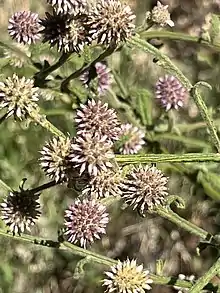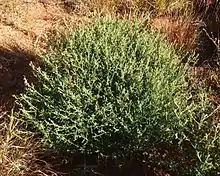| Apple bush | |
|---|---|
 | |
| Scientific classification | |
| Kingdom: | Plantae |
| Clade: | Tracheophytes |
| Clade: | Angiosperms |
| Clade: | Eudicots |
| Clade: | Asterids |
| Order: | Asterales |
| Family: | Asteraceae |
| Genus: | Pterocaulon |
| Species: | P. sphacelatum |
| Binomial name | |
| Pterocaulon sphacelatum | |

Pterocaulon sphacelatum, commonly known as apple bush or fruit-salad plant,[2] is a species of flowering plant in the family Asteraceae. It is an upright shrub with mostly pink to purple flowers and is endemic to Australia.
Description
Pterocaulon sphacelatum is a small understory, perennial herb or shrub to 20–100 cm (7.9–39.4 in) high, stiff upright stems and covered with short brownish woolly or short, matted dense hairs. The leaves are usually oblong to lance-shaped, pointed or nearly so, 1–4 cm (0.39–1.57 in) long, 3–15 mm (0.12–0.59 in) wide, green and hairy on both surfaces, somewhat wrinkled, a distinctive mid-vein, upper leaves slightly scalloped or entire, lower leaves toothed. The solitary flower heads are oval to globe-shaped, 0.8–2 cm (0.31–0.79 in) long, 10–20 mm (0.39–0.79 in) in diameter, sessile or on stalk. The outer bracts are spoon-shaped, inner bracts linear-lance shaped and whitish to pink and the florets pink to purple. Flowering occurs from July to October and the fruit is a brown spindle-shaped achene about 0.7–2 mm (0.028–0.079 in) long, covered in about 15-20 bristles and slightly ribbed. The "applebush" is an aromatic plant is used in Australian Aboriginal medicine.[3][2][4]
Taxonomy and naming
The species was first formally described by Jacques Labillardière as Monenteles sphacelatus. In 1882 Ferdinand von Mueller changed the name to Pterocaulon sphacelatum and attributed the change to George Bentham and the description was published in Systematic Census of Australian Plants.[5][6] The specific epithet (sphacelatum) means "brown or blackish speckling".[7]
Distribution and habitat
Applebush grows in a variety of habitats, mostly on occasional flooded locations, disturbed sites including roadsides in Western Australia, Queensland, New South Wales, Victoria and the Northern Territory.[4]
References
- ↑ "Pterocaulon sphacelatum". Australian Plant Census. Retrieved 1 October 2022.
- 1 2 Porteners, M.F. "Pterocaulon sphacelatum". PlantNET-NSW FLORA ONLINE. Royal Botanic Garden Sydney. Retrieved 30 September 2022.
- ↑ Antiviral flavonoid from Pterocaulon sphacelatum
- 1 2 "Pterocaulon sphacelatum". eFloraSA-Electronic Flora of South Australia. State Herbarium of South Australia. Retrieved 1 October 2022.
- ↑ "Pterocaulon sphacelatum". Australian Plant Name Index. Retrieved 4 October 2022.
- ↑ von Mueller, Ferdinand (1882). Systematic Census of Australian Plants. Melbourne: M'Carron, Bird & Co. p. 79. Retrieved 4 October 2022.
- ↑ Sharr, Francis Aubi; George, Alex (2021). Western Australian Plant Names and Their Meanings (4th ed.). Kardinya, WA: Four Gables Press. p. 320. ISBN 9780958034180.